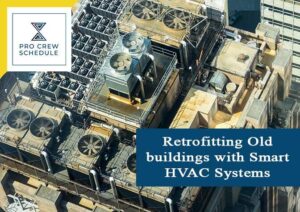Linked smart sensors play a significant role in establishing HVAC systems, particularly for old longstanding buildings. With sensors connected to the current system, its components, including the back-end software, provide data analytics. As a result, old buildings generously receive many benefits from smart HVAC systems. While it isn’t challenging to embrace smart HVAC systems for new buildings because some of them are already installed from the very start, it’s a different challenge for old buildings.
The term “retrofitting” is created, describing old buildings adopting any smart technologies. In older buildings, a battery-operated and wireless sensor platform can be vital as it may be a challenge and can be prohibited to install external cabling alongside walls. With that being said, old buildings are not required to take away any existing HVAC system components to adopt smart HVAC technologies.
How smart HVAC Technology Helps in Modernizing Buildings?
Why are your clients these days wanted to invest in smart technology for their old buildings? The obvious draw is the tremendous cost reductions that will be achieved, whether on operation expenses, energy consumption and even on the cost of space. But there are other compelling reasons that smart sensors, smart HVAC, and other smart building technology will give – a competitive edge:
- Savings can be reinvested in workspace transformation programs. It can help improve collaboration, attract new talents and drive new innovations and sales.
- · Minimized operating expenses will allow companies to invest more and more in revenue. Thus, producing initiatives like the development of services and products.
- There’s greater control over building systems. There’s intelligence needed to make better facilities management and strategic decisions.
- Tracking utilization data that allows companies to pinpoint which property portfolio parts are still working precisely.
- Addressing some problem areas within buildings and systems is easy.
- · The right number of work points are provided on actual utilization patterns.
- Smart HVAC technology provides indisputable and concrete data to support decisions fully and consolidating footprints.
Additionally, subcontractor scheduling software helps HVAC technicians monitor and track every aspect of the job, including task and crew members.
And according to ACEEE, even Smart Sensor Technology can save up to eighteen percent on its annual energy consumption for the entire old building. Smart HVAC includes the following options listed below:
- Advanced rooftop unit controls – RTUs are capable of cutting HVAC energy by 25-40%, depending on settings applied and components used.
- Installing occupancy-based wireless thermostats – by dividing into zones unoccupied, it might save 5-10% of HVAC energy costs.
- CO2 demand-controlled ventilation sensors – it can be integrated with sensors that eventually detect the building’s current occupancy. Ventilations are also adjusted accordingly.
- Smart solar film – can be programmed to adjust according to the standard amount of incoming sunlight. It can help minimize cooling loads by 10-20%.
Retrofitting: Instant Makeover for Old Buildings
Over eighty percent of building construction involves at least one aspect of Smart or IoT building technology. Hence, it is safe to assume that this market mainly serves new buildings. But only five percent from eighty percent have infrastructure that is becoming smart. A growing industry is helping buildings without current infrastructure becomes smarter.
Last 2018, over $500 million was already spent retrofitting old hotels and buildings with smart technology and another $2 billion improving old guest rooms. There were over 1 billion sensors and IoT devices installed in commercial buildings by the end of 2021. Furthermore, an increasing number of startups are already promising that any buildings can become a smart building regardless of location, construction, or age. Therefore, old buildings are no exception.
Let’s thoroughly explore the art of retrofitting old buildings integrated with Smart technology:
1. Smart Sensors Are Turning Old Buildings New
There are four sensors commonly used for smart buildings: a flood sensor, water flow sensor, an A/C monitoring sensor and a sump pump sensor. An A/C monitoring system and sensors are designed to be installed for commercial central A/C units, detecting vapor and liquid pressure, temperature, and even real-time amperage numbers. This device will connect with cellular networks and provide 24/7 remote monitoring of commercial central air conditioning systems. It also detects issues and will notify building and maintenance managers right away.
- Water flow sensors – are designed for water meters in indoor areas, detecting floods, water leaks, temperature, power outages and humidity. The sensor itself can help minimize water bills and even prevent damages because of its instant alerts for any variable changes.
- Flood sensor – sensors focus more on flooding and water leakage in particular.
- Sump pump sensor – detects rising water level, pending sump pump floods and failures, targeting preventing any accidents, and saving on insurance.
2. Reducing Lighting Issues for Energy Savings
HVAC sensors can function properly alongside sensors tied to any window treatments. Energy efficiency is best achieved during the process. In old buildings, properly placed sensors connected to motorized window treatments can pick up sunlight immediately. It can also adjust window shading amidst the course of the day.
Additionally, roller shades compensate for this, and as a result, energy usage gets lower. You can consider using motorized shades because they can cut down both glare and heat. Old building owners wanted building personnel to be more productive and comfortable.
3. Retrofitting Reduces Risks and Saves Money
The good news is that it’s possible to retrofit older buildings with new and highly-efficient HVAC systems. Having partial HVAC system replacements can even mean a huge difference between operational temperature control or not. Thus, making the space in question in terms of comfortability for whatever living or work conditions may be required. An HVAC professional like you should determine what is possible for the given building space. It is also crucial for you to highly prioritize project management for construction.
Moreover, HVAC professionals must know firsthand that it is much less costly to retrofit any older buildings with an upgraded HVAC system than investing it for new building construction. Moreover, if the bones of the old buildings are right, a huge amount of money can be saved on retrofit options and heating and cooling costs.
Below are the other advantages:
- Property value increase
- System reliability and longevity
- Initial cost savings on retrofit versus new construction
- · Decreased moisture penetration
- Improved indoor air quality
- Improve productivity and health for occupants
- · Mold risk reduction
In addition to cost and energy savings, smart HVAC systems improve your customer’s satisfaction and building management efficiency. With smart sensor technology and back-end monitoring and analyzing software, old buildings can significantly benefit from smart HVAC systems without replacing or changing any existing equipment. It is necessary for HVAC professionals to also focus on construction crew management. It increases productivity and intensifies team collaboration, creating a harmonious and unified working relationship to each other.
4. Making Maintenance More Efficient
Smart HVAC systems can only be maintained by experienced HVAC technicians. With the sensors connected to the HVAC system, technicians can keep equipment running continuously and much more efficiently by determining when issues are about to occur. Therefore, maintenance and service calls can be scheduled before any breakdown happens. Through an all-in-one portal for both HVAC technicians and tenants, service calls can be scheduled by client’s preferences, thus minimizing the frequency of off-hour emergency calls.
Most of your clients who are property owners usually have initial insights into their buildings. That is why they often request to remotely adjust the HVAC system according to the time of day and occupancy. Doing so is effective more saving energy. Requesting to modify the system’s behavior is acceptable since they can be aware of how much they save on the utility costs.
HVAC technicians also use another tool for project planning and monitoring. Pro Crew Schedule is the number one in the market! This software application has various features designed for efficient project management. Get a live demo for FREE now!
Smart Sensors Essential for Old Building’s HVAC Systems
Imagine your clients wanted to have greater control over their old building systems and have the intelligence right next to them, ensuring the systems are running correctly. One of the best solutions is smart sensors. These sensors are a modern approach to the optimization of energy consumption. It can cut expenses and save valuable time.
Temperature sensors will monitor old buildings and every part of them. Temperatures and energy consumption can be adjusted and measured through smart sensors. It allows for efficient equipment as it determines the comfort level for occupants.
- Remote Monitoring – smart technology like IoT services provides monitoring solutions. For instance, changing the temperature when nobody is around. Later on, these small changes can make a big difference, particularly in energy efficiency.
- Building Automation Systems – this system can regulate and control every aspect of mechanical services. It may be specifically advantageous to businesses when appliances and equipment are activated or deactivated within the functional life pattern. Thus, savings around workflow and maximizing efficiencies.
- Emergency Alerts – if an old building has business-critical HVAC systems, IoT services may provide emergency alerts specifically for temperature changes. The service can also detect any troubling conditions even before it spirals into complete system failures.
IoT services are an excellent investment for your clients, especially when they are dynamic and very modern. Old buildings can adopt changes when smart technologies are integrated. While your clients can depend on IoT services, as an HVAC contractor relying on web-based project management software like Pro Crew Schedule is your best option. This application is purposely designed for you and your team to collaborate productively, ensuring project completion.
Key Takeaways
Compared to traditional HVAC systems, a smart HVAC system provides many benefits to old buildings, including condition-based maintenance, lower energy consumption, and so on. Hence, retrofitting old buildings and infrastructures is best integrated with smart HVAC technology.







